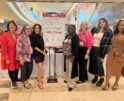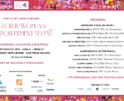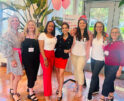
Anna Maria Chávez â CEO, Girl Scouts of the USA

Talk about Gutsy!
By Caroline Cox
Anna Maria Chávez’s path to success wasn’t outlined for her. From becoming the first woman in her family to attend college to becoming the first Latina to head up the Girl Scouts of the USA with its 3.2 million members in 92 countries, she’s not one shy away from creating her own blueprint for success. In fact, she views challenges as opportunities.
After attending law school and landing a job with the government, it was her community involvement with military families that sparked her interest in working with girls. As Girl Scouts of the USA approaches its 100-year anniversary, Chávez says there’s still a ways to go to get more females into leadership roles across the globe. At the helm of this billion-dollar organization, she knows she’s creating a path for girls to follow that she never had herself.
In celebration of International Women’s Day and Girl Scout Week, we invite you to meet Anna Maria Chávez. Here, she talks to Little PINK Book about taking risks, running a nearly billion-dollar organization and helping girls become leaders.
PINK: What’s your success secret?
Anna Maria Chávez: I bring a lot of energy and passion to my work. I’m never working just 50 percent on an issue. When I commit on behalf of people or a cause, I give it everything I have. That creates energy for other people, because it inspires them. Most recently was our national convention where I officially became CEO of the Girl Scouts of the USA in November 2011. It was four days of events and speeches and all sorts of activities. It gave me the opportunity to explain what Girl Scouts had done for me and how it had provided me a platform of success. I’m very happy to be part of it.
PINK: How did you go from your former Girl Scouts position to Girl Scouts of the USA CEO?
AMC: When it was announced that the former CEO was retiring, there was a nationwide search and I was very honored and pleased that they found me in San Antonio. It was a tremendous opportunity. I had seen firsthand the effect Girl Scouts had on girl while serving as CEO of the Girl Scouts of the Southwest Texas and wanted to bring the things I’d learned at that grassroots level to the national organization.
PINK: What’s the best business advice you’ve received?
AMC: My mother said to me, “Anna, all you can do is be yourself and be authentic.” I’ve seen too many women who are high up in the leadership ranks modeling someone else’s leadership style. People want you to be authentic. They want to know the leader of the organization is bringing her true self to the job everyday.

PINK: How has your mom inspired you?
AMC: She is visionary. She ran for local offices back in the 1950s and ‘60s in rural Arizona when a lot of women weren’t running for office. She won two local elections for a position on an elementary school board. She was the first woman to serve on a college board in central Arizona. I learned early on that the reason people resonated with her was because she was honest. People are going to get a good sense of who you are if you’re just yourself. That’s what’s been the recipe for my own professional success.
PINK: What kind of leader are you?
AMC: I asked somebody who was getting her Ph. D in leadership. She said, “You have a democratic kind of leadership style. You give out knowledge like candy.” I’m very transparent. I clearly tell my staff what I’m thinking, what my thought process is and the direction in which we’re going. And I try to even out the hierarchy, regardless of where someone is in the organization.
PINK: What’s your biggest weakness?
AMC: Having high expectations. I’ve always tried to get people to reach for the highest bar possible. But I don’t see that as a weakness. I see that as giving people hope. I’ve always been the type of person who says the glass is half full. I’d rather look at the positive. I used to fund and support homeless and domestic violence shelters in Arizona. I’ve seen people in need – people who have lived in cars for three weeks with their children because they’ve lost their home. I am grateful for every day that I get to wake up and go to a job and work with people who are truly committed to the valuable mission of the organization.
PINK: Why do you think there is a lack of women in leadership positions?
AMC: Unfortunately, in our research and daily work with girls, we see them opting out of leadership opportunities. Studies show girls think leadership is important, and certain models of leadership resonate with them. But the current message they’re getting from society is that they don’t have an inherent quality to lead. All girls have the ability to lead, but we have to give them role models to see that path for themselves. That’s what we’re doing at Girl Scouts – raising awareness around this issue and building partnerships.
PINK: What’s your budget?
AMC: Girl Scouts is a federated system. I have 366 staff members working at our headquarters in New York. They provide support for our more than 3 million Girl Scout members, with Girl Scouts in more than 90 countries. Annually, I’ve got a $60 million budget. But if you combine our assets, it’s almost a billion-dollar organization. The cookie program is the largest entrepreneurial program for girls in the country. In a single year we bring in $760 million from that program. Then girls invest that money into their local communities.
PINK: What do you look for in a hire?
AMC: Loyalty to the organization and the cause – that’s critical. I also want to know if they know how to be a team player, because everybody needs to work together to get things accomplished. They have to bring passion. We work for girls, and it’s the best job in the world. It’s a blessing to be able to work for this organization. I look for people who are coming to the organization because they care about the mission and have energy and humor.
PINK: What was your biggest career obstacle and how did you overcome it?
AMC: It wasn’t so much a career obstacle but a leap of faith. I had spent my entire career in public service. [Then] I had the opportunity to work for the Girl Scouts as CEO of a council in San Antonio. I knew I wanted to work with young people, but this was very different than what I had been doing. So I took a leap of faith and it was the best decision I ever made.
PINK: What made you a risk taker?
AMC: I’ve always been a risk taker. There’s never been a path for me – I’ve been the first in many cases. I was the first person from my high school to go to Yale. I was only one of 16 Hispanic students my freshman year. I was the first female in my family to go to college. In the 100 years Girl Scouts has been around, I am the first woman of color to lead the organization.
PINK: What was your first big risk?
AMC: I moved from Phoenix, Arizona to New Haven, Connecticut to go to Yale. I’d never even seen snow. My parents asked if I wanted them to come with me and I said, “No, I’ve got this!” When I showed up, all the other freshman students were there with their parents, brothers, sisters and cousins. I was there with my two suitcases thinking, “Wow, I guess I should have brought somebody.” But again, there was not a well-trodden path for me, so I didn’t know.
PINK: Would you say you’re a trailblazer?
AMC: I blazed my own trail. I took risks going to Yale, going to law school, going to Washington and going to work for a political organization. I took a risk going into Girl Scouts because I had never worked in the organization. It was a new career path for me. But I never saw these as risks. I saw them as opportunities. One of the main opportunities I had was to move to San Antonio, Texas with my family. I said, “We’re moving to Texas because we’re going to go help girls be leaders.” They said, “OK, we’re moving!” Two and a half years later, the mayor asked me to help run a campaign worth $16 million and I was on the chamber of commerce board of directors, all because I took those risks.
PINK: You were 10 when you first joined the Girl Scouts. Looking back, how has the program changed?
AMC: We had no technology back then. No computers or cell phones. We didn’t have the amazing opportunities girls have today. As a leader, I know we have to be innovative and attuned to girls. We have our own research institute here at headquarters. They do research on boys and girls across the country to get a sense of the issues they’re focused on, what interests them and how we can make it easier for them to explore different career opportunities. Thanks to technology, there could be girls in Savannah, Georgia [birthplace of Girl Scouts of the USA founder Juliette Gordon Low] making friends with girls in Africa or Italy. Girls are living in a completely different environment today.
PINK: What sparked your interest in youth development?
AMC: When I heard about [a job opportunity with] Girl Scouts, I immediately thought about how the organization opened doors and avenues for me. I got the opportunity to lead a Girl Scout council that had been in San Antonio for almost 89 years.
PINK: What is the “To Get Her There” campaign?
AMC: Our long-term goal is to create gender balance [in leadership positions] in one generation. We’re not just taking a bold step for girls – it’s also about America’s future and competitiveness. When you look at the top jobs in this country, women hold only 18 percent of leadership roles. We want to expand those opportunities for more girls to be around the decision-making tables – in academia, in science and technology, in government, in business – to make critical decisions for the future of this country. The only way we can increase parity around leadership roles is by getting girls engaged in that path.

PINK: What’s the biggest concern for working women?
AMC: Balance! Especially if they’re mothers like me who are running a major organization. As a mother of a small child [Michael, age 9], I have to balance my energy and passion at work with raising a child and being happily married [to Robert]. It’s hard trying to have the best of both worlds at the same time.
PINK: How do you balance work and life?
AMC: My amazing little boy brings humor to my life everyday. Every time I go into my purse I find a Lego or piece of gum he put in there. My family keeps me grounded, and spending time with them helps me balance. Sundays are a sacred day in my family. That’s the day they know they have me. We go to church and do things that are important to us. It’s rare that I spend any work time on Sunday because they give me up the rest of the week. They share me with the world. I also love to dance and play golf any time I have an opportunity, which is rare because of traveling and the commitments I have with the organization.
PINK: What are you reading right now?
AMC: I’m reading Built on Values by Anne Rhoades, whom I actually sat down with last week to ask some questions. She was one of the founders of Jet Blue and she’s worked for Southwest Airlines. The book is about building a [business] culture that outperforms the competition. It’s about how to hire team members who are focused on creating values for your organization so customers are receiving fantastic customer service and support. And she was a Girl Scout!
PINK: What’s one thing most people don’t know about you?
AMC: I’m a fanatical Star Wars follower. I love Star Wars.
PINK: What’s your favorite quote?
AMC: I’ve had the same one for almost 20 years. ‘Tell me who you hang out with and I’ll tell you who you are.’
PINK: How do you define success?
AMC: Success for me is being happy everyday. I got some great advice from Frances Hesselbein, CEO of Girl Scouts in the 1970s. I have her desk in my office at headquarters. I got it out of archives and built an office around it. She said, ‘Anna, I served for 5,000 days. There were hard days, but everyday was a great day, because we get to serve girls.’ I jump up every morning and my husband wonders what’s going on because I’m so happy. I hope more people can have that kind of success, because girls are watching. They’re watching how adults emulate leadership and spend their time. If they saw more happy adults working on things they really care about, girls would follow that lead, get into these leadership roles and change the world.
Recommended
-
Fall 2024 EventNovember 19th, 2024
-
REGISTER HERE FOR THE UPCOMING...September 19th, 2024
-
Spring Sales Are Ready To Bloo...March 1st, 2024
-
Two Months Away!August 24th, 2023
-
Pink’s Signature Spring ...May 17th, 2023















